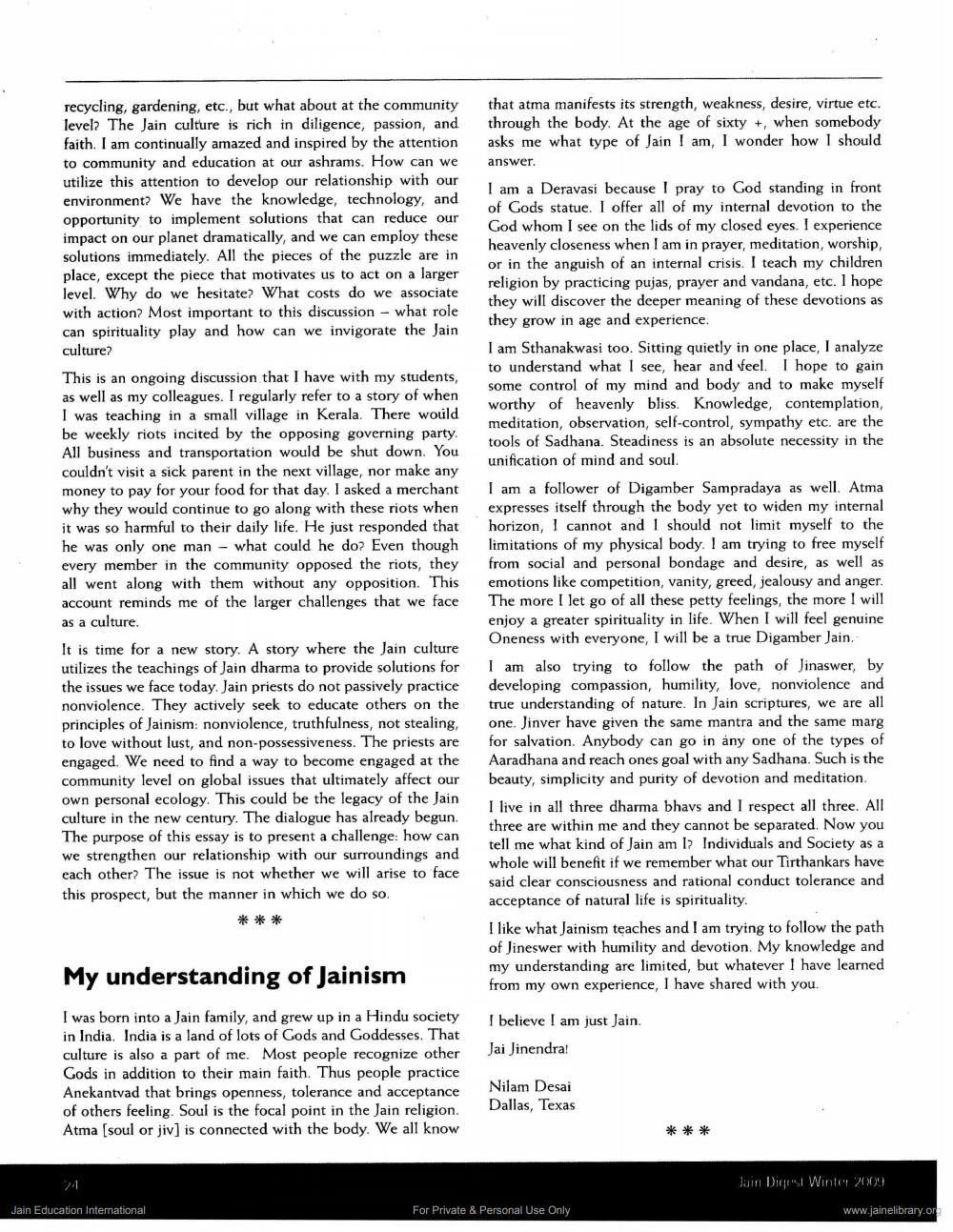________________
recycling, gardening, etc., but what about at the community level? The Jain culture is rich in diligence, passion, and faith. I am continually amazed and inspired by the attention to community and education at our ashrams. How can we utilize this attention to develop our relationship with our environment? We have the knowledge, technology, and opportunity to implement solutions that can reduce our impact on our planet dramatically, and we can employ these solutions immediately. All the pieces of the puzzle are in place, except the piece that motivates us to act on a larger level. Why do we hesitate? What costs do we associate with action? Most important to this discussion - what role can spirituality play and how can we invigorate the Jain culture?
This is an ongoing discussion that I have with my students, as well as my colleagues. I regularly refer to a story of when I was teaching in a small village in Kerala. There would be weekly riots incited by the opposing governing party. All business and transportation would be shut down. You couldn't visit a sick parent in the next village, nor make any money to pay for your food for that day. I asked a merchant why they would continue to go along with these riots when it was so harmful to their daily life. He just responded that he was only one man what could he do? Even though every member in the community opposed the riots, they all went along with them without any opposition. This account reminds me of the larger challenges that we face as a culture.
It is time for a new story. A story where the Jain culture utilizes the teachings of Jain dharma to provide solutions for the issues we face today. Jain priests do not passively practice nonviolence. They actively seek to educate others on the principles of Jainism: nonviolence, truthfulness, not stealing, to love without lust, and non-possessiveness. The priests are engaged. We need to find a way to become engaged at the community level on global issues that ultimately affect our own personal ecology. This could be the legacy of the Jain culture in the new century. The dialogue has already begun. The purpose of this essay is to present a challenge: how can we strengthen our relationship with our surroundings and each other? The issue is not whether we will arise to face this prospect, but the manner in which we do so.
***
My understanding of Jainism
I was born into a Jain family, and grew up in a Hindu society in India. India is a land of lots of Gods and Goddesses. That culture is also a part of me. Most people recognize other Gods in addition to their main faith. Thus people practice Anekantvad that brings openness, tolerance and acceptance of others feeling. Soul is the focal point in the Jain religion. Atma [soul or jiv] is connected with the body. We all know
24
Jain Education International
that atma manifests its strength, weakness, desire, virtue etc. through the body. At the age of sixty +, when somebody asks me what type of Jain I am, I wonder how I should
answer.
I am a Deravasi because I pray to God standing in front of Gods statue. I offer all of my internal devotion to the God whom I see on the lids of my closed eyes. I experience heavenly closeness when I am in prayer, meditation, worship, or in the anguish of an internal crisis. I teach my children religion by practicing pujas, prayer and vandana, etc. I hope they will discover the deeper meaning of these devotions as they grow in age and experience.
I am Sthanakwasi too. Sitting quietly in one place, I analyze to understand what I see, hear and feel. I hope to gain some control of my mind and body and to make myself worthy of heavenly bliss. Knowledge, contemplation, meditation, observation, self-control, sympathy etc. are the tools of Sadhana. Steadiness is an absolute necessity in the unification of mind and soul.
I am a follower of Digamber Sampradaya as well. Atma expresses itself through the body yet to widen my internal horizon, I cannot and I should not limit myself to the limitations of my physical body. I am trying to free myself from social and personal bondage and desire, as well as emotions like competition, vanity, greed, jealousy and anger. The more I let go of all these petty feelings, the more I will enjoy a greater spirituality in life. When I will feel genuine Oneness with everyone, I will be a true Digamber Jain.
I am also trying to follow the path of Jinaswer, by developing compassion, humility, love, nonviolence and true understanding of nature. In Jain scriptures, we are all one. Jinver have given the same mantra and the same marg for salvation. Anybody can go in any one of the types of Aaradhana and reach ones goal with any Sadhana. Such is the beauty, simplicity and purity of devotion and meditation.
I live in all three dharma bhavs and I respect all three. All three are within me and they cannot be separated. Now you tell me what kind of Jain am I? Individuals and Society as a whole will benefit if we remember what our Tirthankars have said clear consciousness and rational conduct tolerance and acceptance of natural life is spirituality.
I like what Jainism teaches and I am trying to follow the path of Jineswer with humility and devotion. My knowledge and my understanding are limited, but whatever I have learned from my own experience, I have shared with you.
I believe I am just Jain.
Jai Jinendra!
Nilam Desai Dallas, Texas
For Private & Personal Use Only
***
Jain Digest Winter 2009
www.jainelibrary.org




